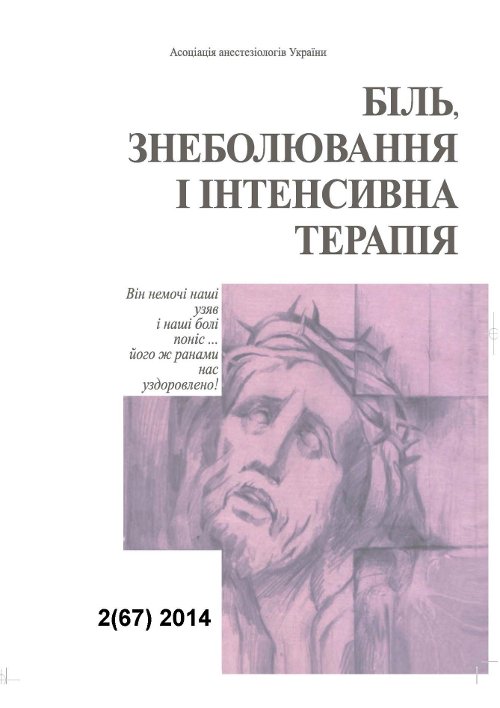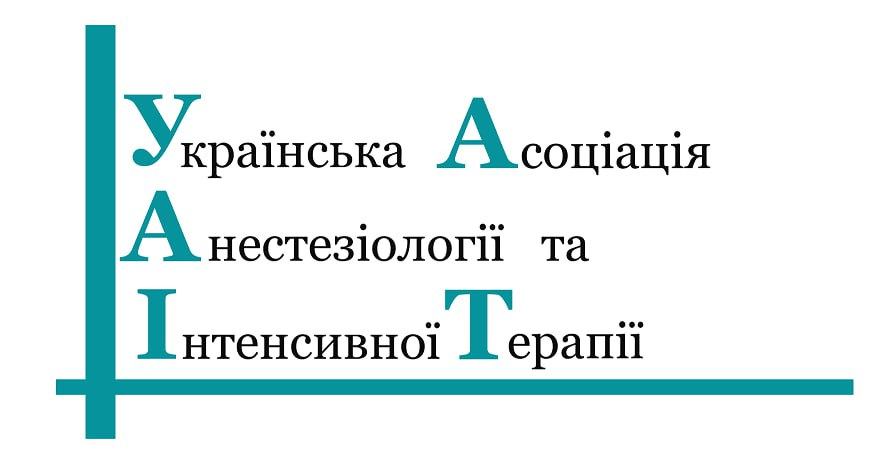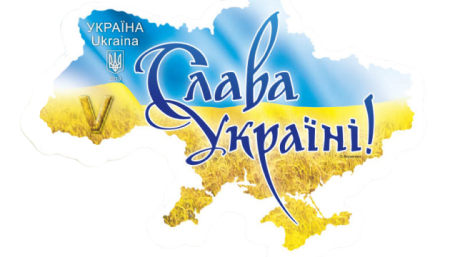Брадикардiя пiд час спiнальної анестезiї
DOI:
https://doi.org/10.25284/2519-2078.2(67).2014.84973Ключові слова:
спiнальна анестезiя, ускладнення, брадикардiяАнотація
Поширенiсть брадикардiї пiд час спiнальної анестезiї – доволi висока (вiд 5 до 13%), тяжка брадикардiя (частота серцевих скорочень менш нiж 40 на хвилину) трапляється рiдше (0,7%). Головний механiзм – «зворотний» рефлекс Бейнбриджа внаслiдок зниженого венозного припливу до правого передсердя. Iншi причиннi фактори: чоловiча стать, частота серцевих скорочень менш нiж 60 на хвилину, вiк молодше за 37 рокiв, тривала операцiя, подовжений iнтервал PQ. Лiкування: атропiн (0,4–1,0 мг), ефедрин (25–50 мг), адреналiн (0,2–0,3 мг). Профiлактика – пiдтримання венозного припливу пiд час i пiсля операцiї. Глибока брадикардiя може призвести до зупинки серця, що потребує торакального масажу.
Посилання
Малрой М. (2003) Местная анестезия: Иллюстрированное практическое руководство. Пер. с англ. М.: БИНОМ. Лаборатория знаний, 301 с.
Caplan R.A., Ward R.J., Posner K., Cheney F.W. (1988) Unexpected cardiac arrest during spinal anesthesia: a closed claims analysis of predisposing factors. Anesthesiology; 68, 1: 5-11. https://doi.org/10.1097/00000542-198801000-00003
Ponhold H., Vicenzi M.N. (1998) Incidence of bradycardia during recovery from spinal anaesthesia: influence of patient position. Br. J. Anaesth; 81, 5: 723-726. https://doi.org/10.1093/bja/81.5.723
Wenk M., Weiss C., Möllmann M., Pöpping D. M. (2012) Procedural complications of spinal anaesthesia in the obese patient. Anesthesiol. Res. Pract: 165267. https://doi.org/10.1155/2012/165267
Kyokong O., Charuluxananan S., Sriprajittichai P., et al. (2006) The incidence and risk factors of hypotension and bradycardia associated with spinal anesthesia. J Med Assoc Thai; 89, suppl 3: S58-S64.
Tarkkila P., Kaukinen S. (1991) Complications during spinal anesthesia: a prospective study. Reg. Anesth;16, 2:101-106.
Carpenter R. L., Caplan R.A., Brown D.L., et al. (1992) Incidence and risk factors for side effects of spinal anesthesia. Anesthesiology; 76,6:906-916. https://doi.org/10.1097/00000542-199206000-00006
Lesser J.B., Sanborn K.V., Valskys R., Kuroda M. (2003) Severe bradycardia during spinal and epidural anesthesia recorded by an anesthesia information management system. Anesthesiology;99, 4:859-866. https://doi.org/10.1097/00000542-200310000-00018
Campagna J.A., Carter C. (2003) Clinical relevance of the Bezold-Jarisch reflex. Anesthesiology;98, 5:1250-1260. https://doi.org/10.1097/00000542-200305000-00030
Crystal G.J., Salem M.R. (2012) The Bainbridge and the “reverse” Bainbridge reflexes: history, physiology, and clinical relevance. Anesth. Analg.;114, 3:520-532. https://doi.org/10.1213/ane.0b013e3182312e21
Greene N.M. (1958) Physiology of Spinal Anesthesia. Baltimore: Williams and Wilkins.
Brooker R.F., Butterworth J.F., Kitzman D.W., et al. (1997) Treatment of hypotension after hyperbaric tetracaine spinal anesthesia. Arandomized, double-blind, cross-over comparison of phenylephrine and epinephrine. Anesthesiology; 86, 4:797-805. https://doi.org/10.1097/00000542-199704000-00009
O’Rourke G.W., Greene N.M. (1970) Autonomic blockade and the resting heart rate in man. Am. Heart J;.80,4:469-474. https://doi.org/10.1016/0002-8703(70)90193-6
Baron J.F., Decaux-Jacolot A., Edouard A., et al. (1986) Influence of venous return on baroreflex control of heart rate during lumbar epidural anesthesia in humans. Anesthesiology; 64,2:188-193. https://doi.org/10.1097/00000542-198602000-00010
Chang K.S., Morrow D.R., Kuzume K., Andresen M.C. (2000) Bupivacaine inhibits baroreflex control of heart rate in conscious rats. Anesthesiology; 92, 1:197-207. https://doi.org/10.1097/00000542-200001000-00032
Bonica J.J., Kennedy W.F., Akamatsu T.J., Gerbershagen H.U. (1972) Circulatory effects of peridural block: 3. Effects of acute blood loss. Anesthesiology;36, 3:219-227. https://doi.org/10.1097/00000542-197203000-00006
Ecoffey C., Edouard A., Prushczynski W., Taly E., Samii K. (1985) Effects of epidural anesthesia on catecholamines, renin activity, and vasopressin changes induced by tilt in elderly men. Anesthesiology;62, 3:294-297. https://doi.org/10.1097/00000542-198503000-00014
Limongi J.A., Lins R.S. (2011) Cardiopulmonary arrest in spinal anesthesia. Rev. Bras. Anestesiol;61, 1:110-120. https://doi.org/10.1016/s0034-7094(11)70012-5
Liguori G.A., Kahn R.L., Gordon J., et al. (1998) The use of metoprolol and glycopyrrolate to prevent hypotensive/bradycardic events during shoulder arthroscopy in the sitting position under interscalene block. Anesth. Analg;87, 6:1320-1325. https://doi.org/10.1213/00000539-199812000-00020
Hampl K.F., Schneider M.C. (1994) Vasovagal asystole before induction of general anaes thesia. Eur. J. Anaesth;11, 2:131-133.
Paul G.E., Carpenter R.L., Stephenson C., Wu R. (1993) Prolonged PR interval associated with increased incidence of bradycardia during spinal anesthesia. Anesthesiology;79: A1086.
Kaimar P., Sanji N., Upadya M., Mohammed K.R. (2012) A comparison of hypotension and bradycardia following spinal anesthesia in patients on calcium channel blockers and β-blockers. Indian J. Pharmacol.;44, 2:193-196. https://doi.org/10.4103/0253-7613.93847
Pontén J., Biber B., Bjurö T., et al. (1982) Beta-receptor blockade and spinal anaesthesia. Withdrawal versus continuation of long-term therapy. Acta Anaesthesiol. Scand. Suppl;76:62-69.
Berry W.R. (2012) Cardiac resuscitation in the operating room: reflections on how we can do better. Can. J. Anaesth;59, 6:522-526. https://doi.org/10.1007/s12630-012-9697-5
Moitra V.K., Gabrielli A., Maccioli G.A., O’Connor M.F. (2012) Anesthesia advanced circulatory life support. Can. J. Anaesth;59, 6:586-603. https://doi.org/10.1007/s12630-012-9699-3
Pollard J.B. (2001) Cardiac arrest during spinal anesthesia: common mechanisms and strategies for prevention. Anesth. Analg;92, 1:252-256. https://doi.org/10.1097/00000539-200101000-00050
Brown D.L., Carpenter R.L., Moore D.C., et al. (1988) Cardiac arrest during spinal anesthesia. III [letter]. Anesthesiology;68, 6:971-972. https://doi.org/10.1097/00000542-198806000-00040
Chamchad D., Horrow J.C., Nakhamchik L., et al. (2011) Prophylactic glycopyrrolate prevents bradycardia after spinal anesthesia for Cesarean section: a randomized, double-blinded, placebo-controlled prospective trial with heart rate variability correlation. J. Clin. Anesth;.23, 5:361-366. https://doi.org/10.1016/j.jclinane.2010.12.008
Barreiro G., van Zundert A., Al-Shaikh B. (2006) Unexpected cardiac arrest in spinal anaesthesia. Acta Anaesthesiol. Belg;57, 4:365-370.
##submission.downloads##
Опубліковано
Як цитувати
Номер
Розділ
Ліцензія
Авторське право (c) 2014 В. С. Фесенко

Ця робота ліцензується відповідно до Creative Commons Attribution-NonCommercial 4.0 International License.
Автори, які публікуються у цьому журналі, погоджуються з наступними умовами:
a. Автори залишають за собою право на авторство своєї роботи та передають журналу право першої публікації цієї роботи на умовах ліцензії Creative Commons Attribution-NonCommercial 4.0 International License, котра дозволяє іншим особам вільно розповсюджувати опубліковану роботу з обов'язковим посиланням на авторів оригінальної роботи та першу публікацію роботи у цьому журналі.
b. Автори мають право укладати самостійні додаткові угоди щодо неексклюзивного розповсюдження роботи у тому вигляді, в якому вона була опублікована цим журналом (наприклад, розміщувати роботу в електронному сховищі установи або публікувати у складі монографії), за умови збереження посилання на першу публікацію роботи у цьому журналі.
c. Політика журналу дозволяє і заохочує розміщення авторами в мережі Інтернет (наприклад, у сховищах установ або на особистих веб-сайтах) рукопису роботи, як до подання цього рукопису до редакції, так і під час його редакційного опрацювання, оскільки це сприяє виникненню продуктивної наукової дискусії та позитивно позначається на оперативності та динаміці цитування опублікованої роботи (див. The Effect of Open Access).








